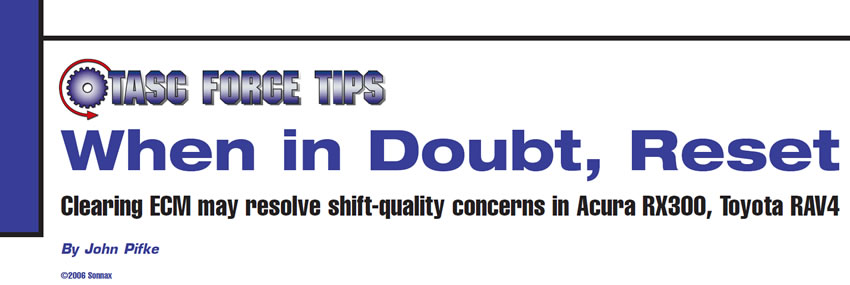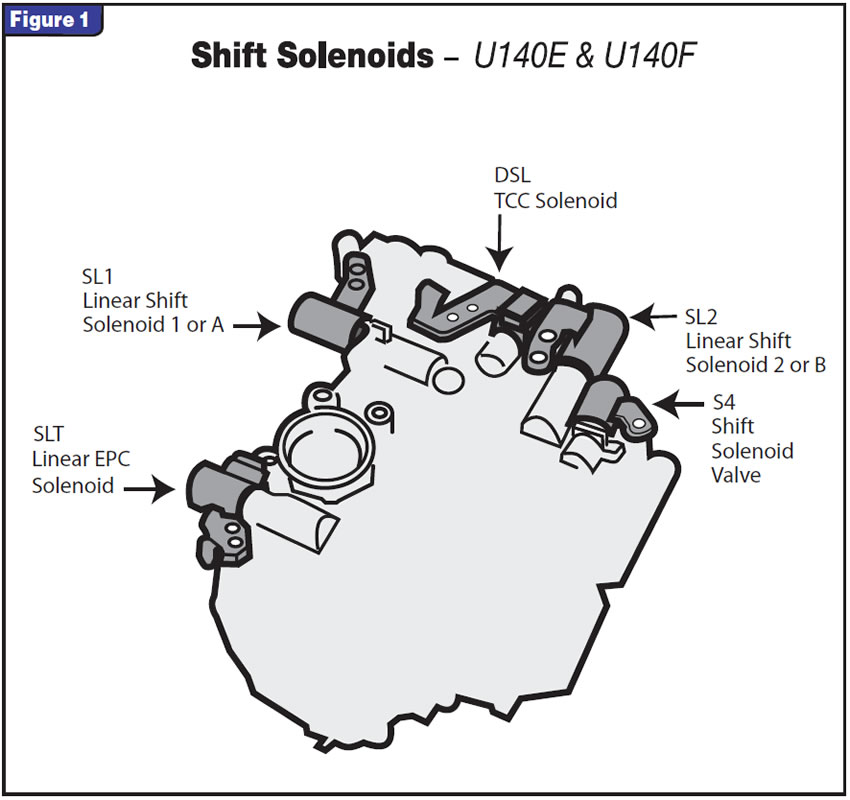
TASC Force Tips
- Author: John Pifke
Clearing ECM may resolve shift-quality concerns in Acura RX300, Toyota RAV4
If you find yourself faced with a1998-up Acura RX300 or a 2000-up Toyota RAV4 with shift-quality concerns, here are a few things you should know before you waste your time chasing wild geese.
Before, during or after your overhaul, you may have to deal with the following:
- DTC P0755 stored (also possible: P0750, P0753, P0758 and/or P1760)
- 2-3 shift flare/bang
- Soft or shuttle shifts
- Burnt direct (C-2) clutch
- Direct-clutch sealing-ring fit and air-check concerns.
This transmission uses linear EPC and shift solenoids. This means the shift solenoids can be modulated just like the EPC. The ECM learns and adjusts the apply characteristics, similar to a 604 or 4T65-E. Like a 604, the old values must be cleared when the transmission is rebuilt. Disconnecting the battery for five minutes can reset most models up to 1999. Many later models can be reset only with a scan tool. So far, the Toyota scan tool appears to be the only one capable of performing this operation. Most of you know by now that if you don’t reset or “quick-learn” a 604 after rebuild, shift quality can be terrible. If you don’t reset the ECM on one of these, you may find yourself taking the unit back apart, looking for what you did wrong.

One thing you may notice during your first pass or if you go back inside is the direct-clutch (C2) sealing rings. These units use plastic (peak) sealing rings with an interlocking joint similar to the late 4L80 rings. The difference is that the Toyota rings have tapered sides and absolutely no outward tension to keep them in contact with the bore wall. As a matter of fact, they have inward tension. If you unlock them and let the ends bypass each other they will overlap about one-sixteenth of an inch. When trial fitted in the bore, they fall right in. You can see daylight between the bore wall and the ring, and when you air-check the clutch you can coax them into leaking like a sieve before they finally pop into position and seal. Forget everything you ever learned about sealing rings: They’re fine. Don’t worry about it. A set of perfectly hand-fit Teflon® butt-gap rings won’t make a bit of difference in the way the unit shifts. Trust me; I tried.
So now you’re wondering what the heck burned the direct clutches, right? Well, it’s possible that the solenoid code actually was caused by a bad shift solenoid and that it burned the clutches.
Another possibility is that the car has a defective ECM. Toyota Technical Service Bulletin TSB TC002-06 may well describe exactly what the car came in for. It tells you to replace the ECM and, if that does not fix the problem, replace the transaxle. (Please note that the ECM replacement may be covered under extended emissions warranty if the vehicle has less than 96 months or 80,000 miles on it.)
Considering that the ECM costs about $900, I suggest that, unless the warranty is going to pay for it, you forgo this option until you’ve had the ECM reset and see how it works. I’m here to tell you that the results can be dramatic, to say the least.
If you find one of these units in your shop with a shift concern, I suggest you proceed as follows:
- Test drive and verify the complaint.
- Scan for codes, and test and/or replace solenoids if needed (see the accompanying valve-body solenoid diagram). Then take it to Toyota and fork over the hundred bucks or so they want for the five minutes it takes to hook up and reset the ECM.
- If this even temporarily fixes the problem, the transmission is probably mechanically fine. Make sure you drive the vehicle for at least half an hour, though, because the problem still may come back. If it does, you will have to replace the ECM.
- If the reset or ECM replacement does not fix the problem, the transmission is probably mechanically damaged. Bear in mind that it is possible to remove the side cover and R&R the direct-clutch drum through the left wheel well. If the clutches are burned, you may well be doing the customer a favor by going for the whole overhaul, because these units also have a problem with premature wear on the front-planet pins with subsequent planet failure. Remember, if you drove it a lot with bad clutches after the ECM was reset or replaced, you may have to reset it again after overhaul.

John Pifke is the owner of Advantage Transmissions in Woodstock, Ill., and a member of the TASC Force (Technical Automotive Specialties Committee), a group of recognized industry technical specialists, transmission rebuilders and Sonnax Industries Inc. technicians. ©2006 Sonnax













